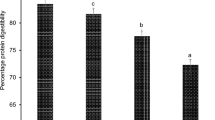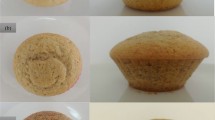Abstract
The high nutritional value of edible insects attracted attention of the food industry for enhancing nutritional characteristics especially protein content of food products. In this study, enrichment of edible insect (Tenebrio molitor and Zophobas atratus) powders into cookie formulations at 0–30% substitution level of wheat flour was tested for their effect on functional and physicochemical properties of cookies. As the substitution level of insect powders increased, the nutritional values, the darkness, redness and yellowness, and the hardness of cookies significantly (p ≤ 0.05) increased, whereas the dough hardness and adhesiveness and the mean scores for all sensory attributes and overall acceptability of cookies decreased. All the cookie samples containing insect powders were microbiologically stable and safe. The cookies enriched with both insect powders up to 20% substitution level were found to be sensorially acceptable. Overall, these results demonstrate a potential application of insect powders to improve nutritional values of cookies.


Similar content being viewed by others
References
Y. Akhtar, M.B. Isman, in Proteins in Food Processing, 2nd edn., ed. by R.Y. Yada (Woodhead Publishing, UK, 2018), pp. 263–288. https://doi.org/10.1016/B978-0-08-100722-8.00011-5
L. Kouřimská, A. Adámková, NFS J. (2016). https://doi.org/10.1016/j.nfs.2016.07.001
D. Menozzi, G. Sogari, M. Veneziani, E. Simoni, C. Mora, Food Qual. Prefer. (2017). https://doi.org/10.1016/j.foodqual.2017.02.001
Q. Yang, S. Liu, J. Sun, L. Yu, C. Zhang, J. Bi, J. Insect Sci. (2014). https://doi.org/10.1093/jisesa/ieu001
EFSA Scientific Committee, EFSA J. (2015). https://doi.org/10.2903/j.efsa.2015.4257
A. Osimani, V. Milanović, F. Cardinali, A. Roncolini, C. Garofalo, F. Clementi, Innov. Food Sci. Emerg. Technol. (2018). https://doi.org/10.1016/j.ifset.2018.06.007
E. Zielińska, M. Karaś, B. Baraniak, LWT Food Sci. Technol. (2018). https://doi.org/10.1016/j.lwt.2018.01.058
B.A. Rumpold, O.K. Schlüter, Mol. Nutr. Food Res. (2013). https://doi.org/10.1002/mnfr.201200735
M. Bawa, S. Songsermpong, C. Kaewtapee, W. Chanput, J. Food Process. Preserv. (2020). https://doi.org/10.1111/jfpp.14601
L.M. de Oliveira, A.J. da Silva Lucas, C.L. Cadaval, M.S. Mellado, Innov. Food Sci. Emerg. Technol. (2017). https://doi.org/10.1016/j.ifset.2017.08.015
C.M. González, R. Garzón, C.M. Rosell, Insects as ingredients for bakery goods. Innov. Food Sci. Emerg. Technol. (2019). https://doi.org/10.1016/j.ifset.2018.03.021
M. Haber, M. Mishyna, J.J.I. Martinez, O. Benjamin, LWT Food Sci. Technol. (2019). https://doi.org/10.1016/j.lwt.2019.108395
A. Roncolini, V. Milanović, F. Cardinali, A. Osimani, C. Garofalo, R. Sabbatini, PLoS ONE (2019). https://doi.org/10.1371/journal.pone.0211747
J.P. Ryu, J.T. Shin, J. Kim, Y.W. Kim, Entomol. Res. (2017). https://doi.org/10.1111/1748-5967.12203
A.O. Akande, O.S. Jolayemi, V.A. Adelugba, S.T. Akande, J. Asia Pac. Entomol. (2020). https://doi.org/10.1016/j.aspen.2020.01.003
C. Delicato, J.J. Schouteten, K. Dewettinck, X. Gellynck, D.A. Tzompa-Sosa, Food Qual. Prefer. (2020). https://doi.org/10.1016/j.foodqual.2019.103755
Y.F. Cheng, R. Bhat, Food Biosci. (2016). https://doi.org/10.1016/j.fbio.2016.03.002
S. van Broekhoven, D.G.A.B. Oonincx, A. van Huis, J.J.A. van Loon, J. Insect Physiol. (2015). https://doi.org/10.1016/j.jinsphys.2014.12.005
AACC International, Approved methods of the American Association of Cereal Chemists, 10th edn. (St. Paul, Minnesota, 2000)
A. Chauhan, D.C. Saxena, S. Singh, LWT Food Sci. Technol. (2015). https://doi.org/10.1016/j.lwt.2015.03.115
AOAC International, Official Methods of Analysis of AOAC International, 20th edn. (Rockville, Maryland, 2016)
A.L. Merrill, B.K. Watt, Energy Value of Foods: Basis and Derivation. Agriculture Handbook No. 74 (ARS United States Department of Agriculture, Washington, 1973)
G.E. Inglett, D. Chen, S.X. Liu, LWT Food Sci. Technol. (2015). https://doi.org/10.1016/j.lwt.2015.03.056
W.H. Andrews, Trends Food Sci. Technol. (1996). https://doi.org/10.1016/0924-2244(96)10017-0
S.P. Cauvain, L.S. Young, Bakery Food Manufacture and Quality: Water Control and Effects, 2nd edn. (Wiley, Oxford, 2008), pp. 263–284
M. Kurniadi, Y. Khasanah, A. Kusumaningrum, M. Angwar, D. Rachmawanti, N.H.R. Parnanto, L.D. Pratiwi, IOP Conf. Ser.: Earth Environ. Sci. (2019). https://doi.org/10.1088/1755-1315/251/1/012034
R. Jan, D.C. Saxena, S. Singh, J. Food Meas. Charact. (2017). https://doi.org/10.1007/s11694-017-9484-7
S. Chevallier, P. Colonna, A. Buléon, G. Della Valle, J. Agric. Food Chem. (2000). https://doi.org/10.1021/jf990435
P. Vasanthakumari, R. Jaganmohan, J. Food Process. Preserv. (2008). https://doi.org/10.1111/jfpp.13824
R. Jan, D.C. Saxena, S. Singh, LWT Food Sci. Technol. (2016). https://doi.org/10.1016/j.lwt.2016.04.001
R.C. Hoseney, D. E. Rogers, in The Science of Cookie and Cracker Production. ed. by H. Faridi (Champman & Hall, New York, 1994), pp. 203–225
K.H. McWatters, J.B. Ouedraogo, A.V.A. Resurreccion, Y.-C. Hung, R.D. Phillips, Int. J. Food Sci. Technol. (2003). https://doi.org/10.1046/j.1365-2621.2003.00716.x
J. Park, I. Choi, Y. Kim, LWT Food Sci. Technol. (2015). https://doi.org/10.1016/j.lwt.2015.03.110
H.C. Klunder, J. Wolkers-Rooijackers, J.M. Korpela, M.J.R. Nout, Food Control (2012). https://doi.org/10.1016/j.foodcont.2012.02.013
Department of Medical Sciences Thailand, Revised guidelines for the assessment of microbiological quality of processed foods. http://dmsclibrary.moph.go.th/ebooks/files/micro-ISBN60.pdf, 2017. Accessed 14 May 2019
H. Khouryieh, F. Aramouni, J. Sci. Food Agric. (2012). https://doi.org/10.1002/jsfa.5642
P. Kittisuban, P. Ritthiruangdej, M. Suphantharika, LWT Food Sci. Technol. (2014). https://doi.org/10.1016/j.lwt.2014.02.045
Acknowledgements
Financial support from Center of Excellence on Biodiversity, Chulalongkorn University is acknowledged. This research is also partially supported by Department of Biotechnology, Faculty of Science, Mahidol University.
Author information
Authors and Affiliations
Contributions
JS: Investigation, Methodology, Formal analysis, Writing—original draft. SK: Funding acquisition, Project administration, Writing—review and editing. MS: Supervision, Conceptualization, Writing—review and editing.
Corresponding author
Ethics declarations
Conflict of interest
The authors have no conflicts of interest to declare that are relevant to the content of this article.
Additional information
Publisher's Note
Springer Nature remains neutral with regard to jurisdictional claims in published maps and institutional affiliations.
Rights and permissions
About this article
Cite this article
Sriprablom, J., Kitthawee, S. & Suphantharika, M. Functional and physicochemical properties of cookies enriched with edible insect (Tenebrio molitor and Zophobas atratus) powders. Food Measure 16, 2181–2190 (2022). https://doi.org/10.1007/s11694-022-01324-2
Received:
Accepted:
Published:
Issue Date:
DOI: https://doi.org/10.1007/s11694-022-01324-2




